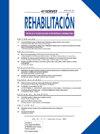The ReDyor study: Effects of prophylactic swallowing exercises on dysphagia and quality of life in patients with head and neck cancer receiving chemoradiation therapy, a randomized clinical trial
IF 0.4
Q3 Medicine
引用次数: 0
Abstract
Objective
To determine the best time to start rehabilitation to preserve swallowing function and enhance health-related quality of life in patients with head and neck cancer (HNC) undergoing chemoradiation therapy (CRT).
Material and methods
Randomized single-blind controlled trial study conducted at a tertiary university hospital. Fifty-two HNC patients treated with CRT were randomized into early intervention (EIG, at diagnosis) and late intervention groups (LIG, post-radiotherapy). Interventions included Inspiratory and Expiratory Muscle Strength Training and standard swallowing exercises for 21 weeks, starting 2 weeks before RT in EIG and immediately after RT in LIG. Functional parameters, dysphagia severity, and HRQoL were assessed at baseline, RT completion, and post-RT follow-ups (3, 6, 12 months).
Results
No significant differences were observed between groups, except for mouth interincisor opening at RT completion in EIG. At final assessment, PEmax% values recovered in EIG but deteriorated in LIG (p = 0.028). Speech problems decreased in EIG (p = 0.019) compared to baseline. PImax showed a positive trend in both groups. Both groups had isolated improvements in quality of life.
Conclusion
The effectiveness of rehabilitation was similar regardless of initiation timing, suggesting both early and late interventions are viable for preserving swallowing function and improving quality of life in HNC patients undergoing CRT.
ReDyor研究:预防性吞咽运动对接受放化疗的头颈癌患者的吞咽困难和生活质量的影响,一项随机临床试验
目的确定头颈癌(HNC)放化疗(CRT)患者开始康复的最佳时间,以保持吞咽功能,提高与健康相关的生活质量。材料与方法在某三级大学附属医院进行的随机单盲对照试验。52例接受CRT治疗的HNC患者随机分为早期干预组(EIG,诊断时)和晚期干预组(LIG,放疗后)。干预措施包括吸气和呼气肌力量训练和标准吞咽练习,为期21周,从EIG治疗前2周开始,LIG治疗后立即开始。功能参数、吞咽困难严重程度和HRQoL在基线、RT完成和RT后随访(3、6、12个月)时进行评估。结果两组间除RT完成时口内切牙开度差异外,无显著性差异。最终评估时,EIG组PEmax%值恢复,而LIG组PEmax%值恶化(p = 0.028)。与基线相比,EIG组的语言问题有所减少(p = 0.019)。PImax在两组患者中均表现出积极的趋势。两组患者的生活质量都有单独的改善。结论无论开始时间如何,康复效果相似,提示早期和晚期干预对于保留HNC患者的吞咽功能和改善CRT患者的生活质量是可行的。
本文章由计算机程序翻译,如有差异,请以英文原文为准。
求助全文
约1分钟内获得全文
求助全文
来源期刊

Rehabilitacion
Medicine-Rehabilitation
CiteScore
0.80
自引率
0.00%
发文量
63
期刊介绍:
La revista que es desde hace más de 40 años la publicación oficial de la Sociedad Española de Rehabilitación y referente de la mayoría de las Sociedades de la Especialidad de los países americanos de habla hispana. Se publican 5 números pluritemáticos al año y uno monográfico sobre un tema del mayor interés y actualidad designado por el consejo de redacción.
 求助内容:
求助内容: 应助结果提醒方式:
应助结果提醒方式:


